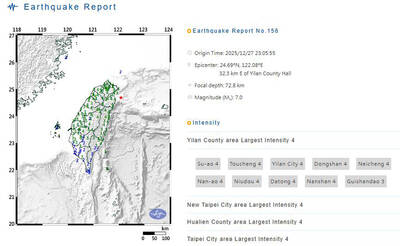President Ma Ying-jeou (馬英九) yesterday accused the Democratic Progressive Party (DPP) of being “impractical” for denying the existence of the so-called “1992 consensus,” saying the term was key to cross-strait negotiations.
While former National Security Council secretary-general Su Chi (蘇起) has admitted he coined the term in 2000, Ma yesterday said “he remembered” that the media began using it in 1992.
Without the consensus, Ma said late Straits Exchange Foundation chairman Koo Chen-fu (辜振甫) would not have met his Chinese counterpart, former Association for Relations Across the Taiwan Strait (ARATS) chairman Wang Daohan (汪道涵), in Singapore in 1993.
“Nor would Beijing have wanted to resume high-level talks with us,” he said.
“The DPP can oppose the ‘1992 consensus,’ but it cannot deny its existence because it is impractical and removed from the facts” he told a gathering of reporters at Taipei Guest House.
Asked to comment on a remark by DPP Chairperson Tsai Ing-wen (蔡英文) on Monday that it was hard for her to recognize the so-called “1992 consensus” as it did not exist, Ma said the DPP had declined to recognize the existence of the consensus for a long time, which contributed to the limited progress it made in improving cross-strait ties during the eight years it was in power.
About one month into his first term, former president Chen Shui-bian (陳水扁) said he would acknowledge the consensus if the Chinese Communist Party (CCP) did the same, Ma said.
Still, Tsai, who was Mainland Affairs Council minister at the time, continues to deny this, he said.
In March 2006, Ma said Chen told him he would “respect” the consensus if China also recognized its existence after he and the former president had a two-hour debate.
“It is clear that the ‘1992 consensus’ exists in the eyes of the KMT [Chinese Nationalist Party] and the CCP,” Ma said.
Although they have different interpretations of “one China,” their definitions carry the “same significance,” he said.
“In other words, both sides agree they reached a consensus in 1992,” he said, adding that his administration’s acceptance of the consensus strengthened China’s willingness to resume cross-strait talks and improve relations.
Ma said that while he was not seeking to embarrass the DPP, he was curious to know how the DPP, if it returned to power, could honor its promise to continue the KMT’s policy if it denied the existence of the consensus.
On cross-strait talks, Ma said they did not necessarily have to be held twice a year and that the scheduling should be more flexible.
He also denied it was time for both sides to tackle more difficult, non-economic issues, saying more urgent issues of an economic nature had yet to be addressed.
Meanwhile, Ma, who doubles as KMT chairman, sought to distance himself from the controversy surrounding maverick party city councilors who failed to vote for party nominees for council speakers and deputy speakers on Saturday, saying he would respect the decision of the party’s local chapters.

A magnitude 7.0 earthquake struck off Yilan at 11:05pm yesterday, the Central Weather Administration (CWA) said. The epicenter was located at sea, about 32.3km east of Yilan County Hall, at a depth of 72.8km, CWA data showed There were no immediate reports of damage. The intensity of the quake, which gauges the actual effect of a seismic event, measured 4 in Yilan County area on Taiwan’s seven-tier intensity scale, the data showed. It measured 4 in other parts of eastern, northern and central Taiwan as well as Tainan, and 3 in Kaohsiung and Pingtung County, and 2 in Lienchiang and Penghu counties and 1

FOREIGN INTERFERENCE: Beijing would likely intensify public opinion warfare in next year’s local elections to prevent Lai from getting re-elected, the ‘Yomiuri Shimbun’ said Internal documents from a Chinese artificial intelligence (AI) company indicated that China has been using the technology to intervene in foreign elections, including propaganda targeting Taiwan’s local elections next year and presidential elections in 2028, a Japanese newspaper reported yesterday. The Institute of National Security of Vanderbilt University obtained nearly 400 pages of documents from GoLaxy, a company with ties to the Chinese government, and found evidence that it had apparently deployed sophisticated, AI-driven propaganda campaigns in Hong Kong and Taiwan to shape public opinion, the Yomiuri Shimbun reported. GoLaxy provides insights, situation analysis and public opinion-shaping technology by conducting network surveillance

Taiwan is gearing up to celebrate the New Year at events across the country, headlined by the annual countdown and Taipei 101 fireworks display at midnight. Many of the events are to be livesteamed online. See below for lineups and links: Taipei Taipei’s New Year’s Party 2026 is to begin at 7pm and run until 1am, with the theme “Sailing to the Future.” South Korean girl group KARA is headlining the concert at Taipei City Hall Plaza, with additional performances by Amber An (安心亞), Nick Chou (周湯豪), hip-hop trio Nine One One (玖壹壹), Bii (畢書盡), girl group Genblue (幻藍小熊) and more. The festivities are to

AFTERMATH: The Taipei City Government said it received 39 minor incident reports including gas leaks, water leaks and outages, and a damaged traffic signal A magnitude 7.0 earthquake struck off Taiwan’s northeastern coast late on Saturday, producing only two major aftershocks as of yesterday noon, the Central Weather Administration (CWA) said. The limited aftershocks contrast with last year’s major earthquake in Hualien County, as Saturday’s earthquake occurred at a greater depth in a subduction zone. Saturday’s earthquake struck at 11:05pm, with its hypocenter about 32.3km east of Yilan County Hall, at a depth of 72.8km. Shaking was felt in 17 administrative regions north of Tainan and in eastern Taiwan, reaching intensity level 4 on Taiwan’s seven-tier seismic scale, the CWA said. In Hualien, the